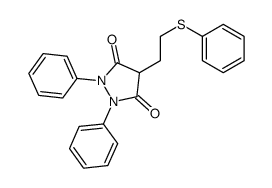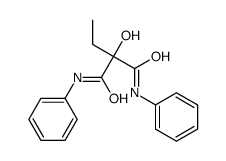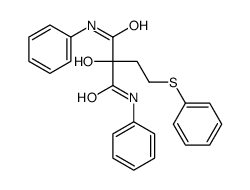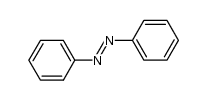57-96-5
| 中文名 | (±)-磺吡酮 |
|---|---|
| 英文名 | sulfinpyrazone |
| 中文别名 |
磺吡酮
苯磺保泰松 |
| 英文别名 |
sulphinpyrazone
3,5-Pyrazolidinedione, 1,2-diphenyl-4-[2-(phenylsulfinyl)ethyl]- Diphenylpyrazone Sulfinpyrazon Anturane Sulfoxyphenylpyrazolidine EINECS 200-357-4 1,2-Diphenyl-4-[2-(phenylsulfinyl)ethyl]-3,5-pyrazolidinedione 1,2-Diphenyl-4-[2-(phenylsulfinyl)ethyl]-1H-pyrazol-3,5(2H,4H)-dion Enturan Anturano Enturen ulfinpyrazone Anturan MFCD00057279 Sulfinpyrazone 4-[2-(benzenesulfinyl)ethyl]-1,2-diphenylpyrazolidine-3,5-dione Anturidin Anturanil 1,2-Diphenyl-4-[2-(phenylsulfinyl)ethyl]pyrazolidine-3,5-dione (+/-)-Sulfinpyrazone |
| 描述 | Sulfinpyrazone (G-28315) 是可针对慢性和间歇性痛风性关节炎的一种口服有效的尿酸剂 (uricosuric agent)。Sulfinpyrazone 具有抗血栓和血小板抑制作用。 |
|---|---|
| 相关类别 | |
| 体外研究 | 亚磺吡唑酮(G-28315)刺激纤溶活性[2]。 |
| 体内研究 | 在高岭土致大鼠足肿胀模型中,亚磺吡唑酮(G-28315)口服30mg/kg可恢复明显延长的球蛋白溶解时间。除这些作用外,亚磺吡唑酮还可保护家兔在单次口服10-30mg/kg花生四烯酸诱导的猝死[2]。 |
| 参考文献 |
| 密度 | 1.4±0.1 g/cm3 |
|---|---|
| 沸点 | 590.8±42.0 °C at 760 mmHg |
| 熔点 | >300 °C(lit.) |
| 分子式 | C23H20N2O3S |
| 分子量 | 404.482 |
| 闪点 | 311.1±27.9 °C |
| 精确质量 | 404.119476 |
| PSA | 76.90000 |
| LogP | 2.30 |
| 外观性状 | 固体;White to Light yellow powder to crystal |
| 蒸汽压 | 0.0±1.7 mmHg at 25°C |
| 折射率 | 1.717 |
| 储存条件 | 2-8°C |
| 水溶解性 | soluble |
| 分子结构 | 五、分子性质数据: 1、 摩尔折射率:114.13 2、 摩尔体积(m3/mol):290.0 3、 等张比容(90.2K):856.1 4、 表面张力(dyne/cm):75.9 5、 极化率(10 -24cm 3):45.24 |
| 计算化学 | 1.疏水参数计算参考值(XlogP):无 2.氢键供体数量:0 3.氢键受体数量:4 4.可旋转化学键数量:6 5.互变异构体数量:2 6.拓扑分子极性表面积76.9 7.重原子数量:29 8.表面电荷:0 9.复杂度:571 10.同位素原子数量:0 11.确定原子立构中心数量:0 12.不确定原子立构中心数量:1 13.确定化学键立构中心数量:0 14.不确定化学键立构中心数量:0 15.共价键单元数量:1 |
|
SECTION 1: Identification of the substance/mixture and of the company/undertaking Product identifiers Product name: (±)-Sulfinpyrazone REACH No.: A registration number is not available for this substance as the substance or its uses are exempted from registration, the annual tonnage does not require a registration or the registration is envisaged for a later registration deadline.
CAS-No.: 57-96-5 Relevant identified uses of the substance or mixture and uses advised against Identified uses: Laboratory chemicals, Manufacture of substances SECTION 2: Hazards identification Classification of the substance or mixture Classification according to Regulation (EC) No 1272/2008 Acute toxicity, Oral (Category 4), H302 For the full text of the H-Statements mentioned in this Section, see Section 16. Classification according to EU Directives 67/548/EEC or 1999/45/EC Xn HarmfulR22 For the full text of the R-phrases mentioned in this Section, see Section 16. Label elements Labelling according Regulation (EC) No 1272/2008 Pictogram Signal wordWarning Hazard statement(s) H302Harmful if swallowed. Precautionary statement(s)none Supplemental Hazardnone Statements Safety data sheet available on request. Other hazards - none SECTION 3: Composition/information on ingredients Substances Synonyms: 1,2-Diphenyl-4-(phenylsulfinylethyl)-3,5-pyrazolidinedione Formula: C23H20N2O3S Molecular Weight: 404,48 g/mol CAS-No.: 57-96-5 EC-No.: 200-357-4 Hazardous ingredients according to Regulation (EC) No 1272/2008 ComponentClassificationConcentration Sulfinpyrazone CAS-No.57-96-5Acute Tox. 4; H302<= 100 % EC-No.200-357-4 Hazardous ingredients according to Directive 1999/45/EC ComponentClassificationConcentration Sulfinpyrazone CAS-No.57-96-5Xn, R22<= 100 % EC-No.200-357-4 For the full text of the H-Statements and R-Phrases mentioned in this Section, see Section 16 SECTION 4: First aid measures Description of first aid measures General advice Consult a physician. Show this safety data sheet to the doctor in attendance. If inhaled If breathed in, move person into fresh air. If not breathing, give artificial respiration. Consult a physician. In case of skin contact Wash off with soap and plenty of water. Consult a physician. In case of eye contact Flush eyes with water as a precaution. If swallowed Never give anything by mouth to an unconscious person. Rinse mouth with water. Consult a physician. Most important symptoms and effects, both acute and delayed The most important known symptoms and effects are described in the labelling (see section 2.2) and/or in section 11 Indication of any immediate medical attention and special treatment needed no data available SECTION 5: Firefighting measures Extinguishing media Suitable extinguishing media Use water spray, alcohol-resistant foam, dry chemical or carbon dioxide. Special hazards arising from the substance or mixture Carbon oxides, nitrogen oxides (NOx), Sulphur oxides Advice for firefighters Wear self contained breathing apparatus for fire fighting if necessary. Further information no data available SECTION 6: Accidental release measures Personal precautions, protective equipment and emergency procedures Use personal protective equipment. Avoid dust formation. Avoid breathing vapours, mist or gas. Ensure adequate ventilation. Avoid breathing dust. For personal protection see section 8. Environmental precautions Do not let product enter drains. Methods and materials for containment and cleaning up Pick up and arrange disposal without creating dust. Sweep up and shovel. Keep in suitable, closed containers for disposal. Reference to other sections For disposal see section 13. SECTION 7: Handling and storage Precautions for safe handling Avoid contact with skin and eyes. Avoid formation of dust and aerosols. Provide appropriate exhaust ventilation at places where dust is formed.Normal measures for preventive fire protection. For precautions see section 2.2. Conditions for safe storage, including any incompatibilities Store in cool place. Keep container tightly closed in a dry and well-ventilated place. Specific end use(s) A part from the uses mentioned in section 1.2 no other specific uses are stipulated SECTION 8: Exposure controls/personal protection Control parameters Components with workplace control parameters Exposure controls Appropriate engineering controls Handle in accordance with good industrial hygiene and safety practice. Wash hands before breaks and at the end of workday. Personal protective equipment Eye/face protection Safety glasses with side-shields conforming to EN166 Use equipment for eye protection tested and approved under appropriate government standards such as NIOSH (US) or EN 166(EU). Skin protection Handle with gloves. Gloves must be inspected prior to use. Use proper glove removal technique (without touching glove's outer surface) to avoid skin contact with this product. Dispose of contaminated gloves after use in accordance with applicable laws and good laboratory practices. Wash and dry hands. The selected protective gloves have to satisfy the specifications of EU Directive 89/686/EEC and the standard EN 374 derived from it. Body Protection Complete suit protecting against chemicals, The type of protective equipment must be selected according to the concentration and amount of the dangerous substance at the specific workplace. Respiratory protection For nuisance exposures use type P95 (US) or type P1 (EU EN 143) particle respirator.For higher level protection use type OV/AG/P99 (US) or type ABEK-P2 (EU EN 143) respirator cartridges. Use respirators and components tested and approved under appropriate government standards such as NIOSH (US) or CEN (EU). Control of environmental exposure Do not let product enter drains. SECTION 9: Physical and chemical properties Information on basic physical and chemical properties a) AppearanceForm: solid b) Odourno data available c) Odour Thresholdno data available d) pHno data available e) Melting point/freezingno data available point f) Initial boiling point and no data available boiling range g) Flash pointno data available h) Evapouration rateno data available i) Flammability (solid, gas) no data available j) Upper/lowerno data available flammability or explosive limits k) Vapour pressureno data available l) Vapour densityno data available m) Relative densityno data available n) Water solubilityno data available o) Partition coefficient: n- no data available octanol/water p) Auto-ignitionno data available temperature q) Decompositionno data available temperature r) Viscosityno data available s) Explosive propertiesno data available t) Oxidizing propertiesno data available Other safety information no data available SECTION 10: Stability and reactivity Reactivity no data available Chemical stability Stable under recommended storage conditions. Possibility of hazardous reactions no data available Conditions to avoid no data available Incompatible materials Strong oxidizing agents Hazardous decomposition products Other decomposition products - no data available In the event of fire: see section 5 SECTION 11: Toxicological information Information on toxicological effects Acute toxicity LD50 Oral - rat - 358 mg/kg Skin corrosion/irritation no data available Serious eye damage/eye irritation no data available Respiratory or skin sensitisation no data available Germ cell mutagenicity no data available Carcinogenicity IARC:No component of this product present at levels greater than or equal to 0.1% is identified as probable, possible or confirmed human carcinogen by IARC. Reproductive toxicity no data available Specific target organ toxicity - single exposure no data available Specific target organ toxicity - repeated exposure no data available Aspiration hazard no data available Additional Information RTECS: UQ8575000 Gastrointestinal disturbance, Vomiting, Diarrhoea SECTION 12: Ecological information Toxicity no data available Persistence and degradability no data available Bioaccumulative potential no data available Mobility in soil no data available Results of PBT and vPvB assessment PBT/vPvB assessment not available as chemical safety assessment not required/not conducted Other adverse effects no data available SECTION 13: Disposal considerations Waste treatment methods Product Offer surplus and non-recyclable solutions to a licensed disposal company. Contact a licensed professional waste disposal service to dispose of this material. Dissolve or mix the material with a combustible solvent and burn in a chemical incinerator equipped with an afterburner and scrubber. Contaminated packaging Dispose of as unused product. SECTION 14: Transport information UN number ADR/RID: -IMDG: -IATA: - UN proper shipping name ADR/RID: Not dangerous goods IMDG: Not dangerous goods IATA:Not dangerous goods Transport hazard class(es) ADR/RID: -IMDG: -IATA: - Packaging group ADR/RID: -IMDG: -IATA: - Environmental hazards ADR/RID: noIMDG Marine pollutant: noIATA: no Special precautions for user no data available SECTION 15 - REGULATORY INFORMATION N/A SECTION 16 - ADDITIONAL INFORMATION N/A |
|
毒理学数据: 1 、急性毒性:人经口TDLo:29mg/kg;大鼠经口LD50:358mg/kg;大鼠静脉LDLo:154mg/kg;小鼠经口LD50:.298mg/kg; 小鼠腹腔LD50:100mg/kg;小鼠静脉LD50:240mg/kg;兔子静脉LD50:195mg/kg 2、致突变性:性染色体的损失和nondisjunctionTEST系统:模具-构巢曲霉:1mg/L CHEMICAL IDENTIFICATION
HEALTH HAZARD DATAACUTE TOXICITY DATA
MUTATION DATA
|
| 符号 |

GHS07 |
|---|---|
| 信号词 | Warning |
| 危害声明 | H302 |
| 警示性声明 | P301 + P312 + P330 |
| 个人防护装备 | dust mask type N95 (US);Eyeshields;Faceshields;Gloves |
| 危害码 (欧洲) | Xn:Harmful; |
| 风险声明 (欧洲) | R22 |
| 安全声明 (欧洲) | S36 |
| 危险品运输编码 | NONH for all modes of transport |
| WGK德国 | 3 |
| RTECS号 | UQ8575000 |
| 海关编码 | 2933990090 |
| 上游产品 2 | |
|---|---|
| 下游产品 5 | |
| 海关编码 | 2933990090 |
|---|---|
| 中文概述 | 2933990090. 其他仅含氮杂原子的杂环化合物. 增值税率:17.0%. 退税率:13.0%. 监管条件:无. 最惠国关税:6.5%. 普通关税:20.0% |
| 申报要素 | 品名, 成分含量, 用途, 乌洛托品请注明外观, 6-己内酰胺请注明外观, 签约日期 |
| Summary | 2933990090. heterocyclic compounds with nitrogen hetero-atom(s) only. VAT:17.0%. Tax rebate rate:13.0%. . MFN tariff:6.5%. General tariff:20.0% |







![2-[2-(benzenesulfinyl)ethyl]-2-hydroxy-N,N'-diphenylpropanediamide结构式](https://image.chemsrc.com/caspic/458/94344-87-3.png)
